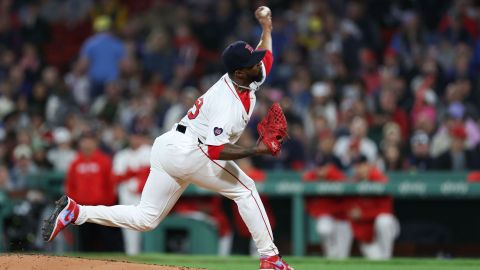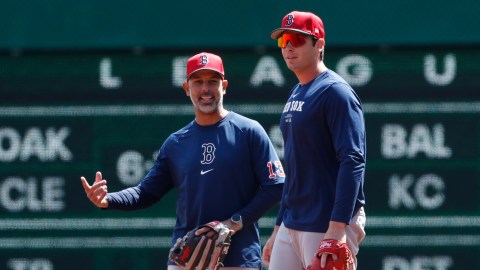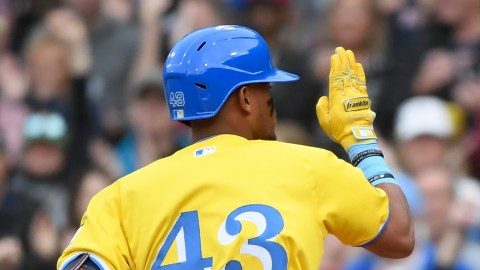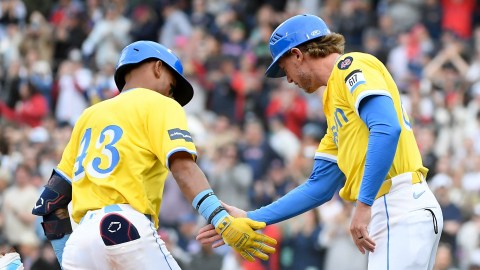When Victor Martinez signed with Detroit and Adrian Beltre gave every indication he would be moving on as well, there were some fans in Boston who wondered how those holes could be filled.
Obviously, those spots were taken up with parts of what is a pretty loaded roster, and the rewards of letting Martinez and Beltre walk will be reaped next week during the Major League Baseball First-Year Player Draft, which is to be held Monday through Wednesday.
As Type A free agents, Martinez and Beltre netted the Red Sox the first-round picks of their signing teams, along with a compensation pick as well. Boston lost its first-round pick with the Carl Crawford signing, but the end result is four picks in the top 40, something that has team officials very excited about the organization’s chances to do some serious damage in the draft.
“It’s always a great feeling to have extra picks,” general manager Theo Epstein said. “I think it energizes the scouting staff for the whole year because they know going in and seeing players that there’s a much better chance that they can actually get a guy, instead of seeing someone they like and realize they’re going to go before we pick.
“It energizes the whole staff and when you get into a room and put them all together, it’s exciting. When you rank the first 40 guys, you get four of them so that’s a nice feeling. Now we just have to do our job and put them in the right order and see how things break on Monday.”
Epstein and Amiel Sawdaye, the organization’s director of amateur scouting, indicated that they are entering a rather loaded draft, which is one of the big reasons why Epstein was OK letting Martinez and Beltre go. The talent pool is loaded with quality pitching at the college level, as well as a handful of players that some scouts are absolutely drooling over.
Many of them will not make it to Boston’s first pick at No. 19. At that point, there is a rather even talent level all the way through the supplemental round, which gives a prepared war room the chance to one-up its competition.
There is extra incentive for the Red Sox to get it right this year. This could be one of the last drafts that contain supplemental rewards for departing free agents. A new collective bargaining agreement could do away with those perks, as well as institute concrete slotting measures that would hinder the ability for big-money ball clubs to offer exorbitant signing bonuses.
Epstein said it is impossible to alter his plan of attack based on the unknown. However, he knows that alterations in the future could make the present that much more important.
“We recognize that’s the situation right now, so we’ll take advantage of it while we can,” he said. “We’re in a wait-and-see approach. Who knows what the next collective bargaining agreement might look like? Because of the uncertainty, it puts an emphasis on the moment now. Taking advantage of the system as it exists now, let’s work extra hard, let’s get an extra look and let’s do everything we can to make the right selections when we can.
“There might be a day we wake up and we are talking fondly of bygone days when we had four of the first 40 picks of the draft. No team will have something like that again. Who knows what the next system will be? You’ve got to take advantage of this model while it exists.”
The Red Sox went into last year’s draft in a very similar position, sporting three of the first 39 picks and four of the first 59 in what was considered an above-average draft. They were thrilled with how the front end of that draft went, and with good reason. Each of the first four they took has delighted thus far, making Sawdaye’s first year in his role a rewarding one.
Sawdaye discussed the atmosphere before his first selection last year, and admitted he is happy to have the experience under him this year, knowing that best-laid plans can often come to fruition.
“We selected Kolbrin Vitek and it was a nail-biter until the end,” Sawdaye said. “We didn’t know if we were going to get the player we really liked, and we did in the end. He was the player we coveted, and I think it helps to calm the nerves.”
Vitek and Bryce Brentz, the second pick last year, are performing well so far this year. Brentz already earned a promotion to advanced Single-A Salem after a phenomenal start one level below. Anthony Ranaudo, the first pitcher the team selected at No. 39, was also promoted to Salem this week after opening his professional career 4-1 with a 3.33 ERA. Brandon Workman, taken with the 59th overall pick, has struck out 40 and walked only nine in 10 starts for Single-A Greenville.
All four were college players. That was a byproduct of last year’s talent pool, which was marked by a lean high school base. Still, the prep level remains intriguing, and the Bay State is adding its fair share of prospects this time around, most notably Lawrence Academy’s Tyler Beede.
Having a few more local players to check out has also added some buzz.
“That’s exciting, to be able to go to local guys and see those guys pitch, it’s exciting for us,” Sawdaye said. “Getting home games. We normally don’t get those until we go to the [Cape Cod League in the summer].”
However, there likely won’t be any picks made based on sentiment, nor will any be made based on position need. That is a mind-set that almost always exists for the organization, except in very rare circumstances.
It also can be a bit more difficult to project the younger kids, although that’s what makes the process something that Epstein cherishes.
“Amateur scouting in baseball is much more difficult and much more complicated,” he said. “You’re looking at 17-, 18-year-old kids in high school often playing against poor completion and you’re trying to project what they’re going to look like, what they’re going to pitch like, what they’re going to be like as people 10 years later when they’re 27. … It’s a fascinating process.”
The Red Sox’ success in the process has produced a litany of big leaguers. Dustin Pedroia, Kevin Youkilis, Jacoby Ellsbury, Jed Lowrie, Jon Lester, Clay Buchholz, Jonathan Papelbon, Daniel Bard. They all were drafted in the course of the last decade, all but Youkilis and Lester under Epstein’s watch. Additionally, Adrian Gonzalez was acquired for the price of three others who were part of the system, a point not lost on the GM.
So while the eyes of many Red Sox fans will be on the three-game series in New York next week, the future of the franchise will largely hang in the balance in nearby Secaucus, N.J., where the first day of the draft will be conducted.
“It’s been probably the biggest factor in the success of this organization from a baseball operations standpoint over the last 10 years,” Epstein added. “We’ve built much of this team through the draft, and also used the draft for prospects to trade for other important members of this team.
“If you have bad drafts two out of three years, three out of four years, that’s going to be reflected in the downturn in the success of the organization overall. The work that our scouts are doing now will play an important role in how we feel about the Red Sox four, five years from now.”



